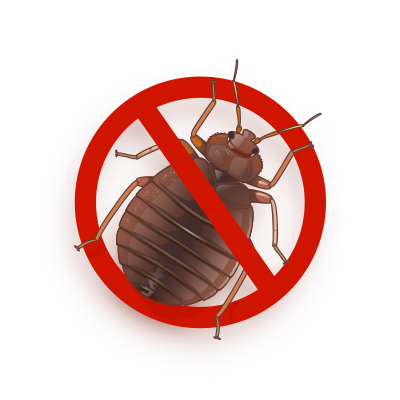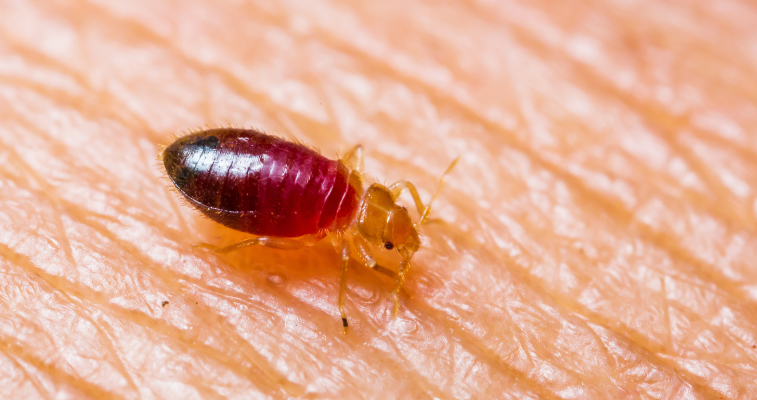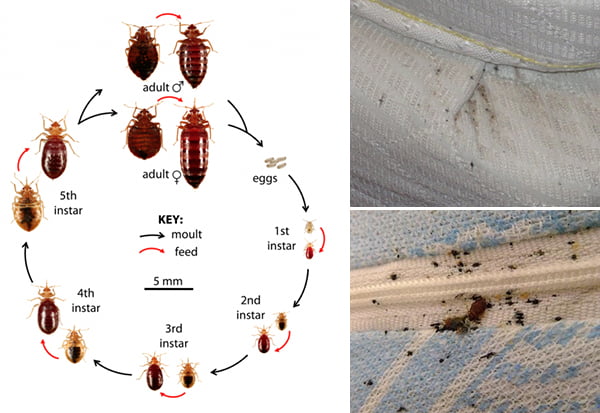To stop bed bugs, thoroughly clean and declutter your home, vacuum regularly, seal any cracks and crevices, and use mattress and box spring encasements. Dealing with a bed bug infestation can be frustrating and stressful.
Fortunately, there are effective steps you can take to stop bed bugs from spreading and eliminate them from your home. By following a few simple strategies, you can regain control and create a bed bug-free environment for you and your family.
We’ll explore various methods and techniques to stop bed bugs, providing you with practical tips to tackle this common household pest. Whether you’re dealing with a minor infestation or a more severe problem, we’ll cover everything you need to know to effectively deal with bed bugs and prevent future outbreaks.

Credit: hicare.in
Preventing Bed Bug Infestations
Prevent bed bug infestations by regularly inspecting and cleaning bedding, furniture, and luggage. Seal cracks and gaps to limit bed bug access, and use protective covers on mattresses and pillows. Consider professional pest control for severe infestations. Regular vacuuming and washing can also help eradicate bed bugs.
Inspecting Your Surroundings
Regularly check for signs of bed bugs like bloodstains or tiny dark spots on mattresses and furniture.
- Examine cracks and crevices in walls, furniture, and electrical outlets for eggs or bugs.
- Use a flashlight to inspect suspect areas thoroughly and be vigilant while investigating.
Securing Your Home
Seal any cracks or gaps in walls, furniture, and baseboards to limit bed bug entry points.
- Consider using bed bug-proof mattress covers to prevent infestation in your sleeping area.
- Declutter your living spaces to eliminate hiding spots for bed bugs.
Taking Precautions While Traveling
Inspect your hotel room for signs of bed bugs upon arrival to avoid bringing them home.
| Precautions | Actions |
|---|---|
| Keep luggage off the floor | Store bags on luggage racks or in the bathroom to prevent bed bugs from hitching a ride. |
| Inspect bedding and furniture | Check the mattress seams, headboard, and nightstands for any signs of bed bugs. |
Identifying Bed Bugs
Recognizing Bed Bug Bites is the first step in identifying a potential bed bug infestation. Bed bug bites are small, red, and itchy bumps that may appear in a clustered pattern on the skin.
Recognizing Bed Bug Bites
- Bites appear as small, red, itchy bumps
- Clusters of bites in a line or zigzag pattern
- Bites usually on exposed skin areas
Spotting Bed Bug Signs
- Bloodstains on sheets or pillowcases
- Dark spots of bed bug feces on mattresses
- Eggshells or shed skins in hiding spots
Using Bed Bug Detection Tools can help confirm the presence of bed bugs in your home. Tools such as bed bug traps, mattress encasements, and flashlights can aid in identifying and monitoring bed bug activity.
Using Bed Bug Detection Tools
- Inspecting bedding and furniture with a flashlight
- Placing bed bug traps under furniture legs
- Using mattress encasements to trap bed bugs
Treating Bed Bug Infestations
If you find yourself dealing with a bed bug infestation, it’s crucial to take immediate action to prevent further spread and eliminate these pests from your home. In this section, we will explore different methods of treating bed bug infestations, including hiring a professional exterminator, using DIY treatments, and employing non-chemical solutions.
Hiring A Professional Exterminator
When it comes to severe or persistent bed bug infestations, it is often best to enlist the help of a professional exterminator. These experts are trained in identifying and eliminating bed bugs effectively. They have access to specialized equipment and treatment methods that target even hidden infestations.
A professional exterminator will conduct a thorough inspection of your home to identify the extent of the infestation. Based on their findings, they will develop a customized treatment plan to eradicate the bed bugs. This may involve a combination of techniques such as steam treatment, heat treatment, and the use of targeted insecticides.
It’s important to note that hiring a professional exterminator can be more expensive than DIY treatments. However, it can save you time, stress, and the possibility of ineffective treatments that allow the infestation to persist.
Using Diy Treatments
If the infestation is relatively small or localized, you may choose to tackle the problem yourself using DIY treatments. While DIY treatments can be effective, they may not fully eliminate the infestation if not executed properly.
Before starting any DIY treatment, it’s essential to thoroughly research and understand the process. This includes identifying the signs of bed bugs, locating their hiding spots, and ensuring you have the right tools and products.
Common DIY treatments for bed bug infestations include washing infested fabrics in hot water, vacuuming thoroughly, and applying bed bug powders or sprays. It’s important to follow the instructions carefully and repeat treatments as necessary to ensure all bed bugs, including their eggs, are eliminated.
If you choose to use DIY treatments, it’s crucial to be patient as eradicating bed bugs can take time. Additionally, monitor your living spaces regularly to catch any signs of a resurgence and address them promptly.
Employing Non-chemical Solutions
If you prefer to avoid chemical treatments or have concerns about their potential side effects, there are non-chemical solutions available for treating bed bug infestations.
One non-chemical method is heat treatment. Bed bugs cannot survive in temperatures above 120 degrees Fahrenheit, so exposing infested items to high heat can effectively kill them. This can be accomplished through the use of steamers, clothes dryers on high heat settings, or specialized heat chambers.
Cold treatment is another non-chemical option. Bed bugs are susceptible to freezing temperatures, so placing infested items in a freezer for several days can kill them. However, it’s important to note that freezing may not penetrate deep enough to eliminate all bed bugs and their eggs.
In addition, physical methods such as encasing mattresses and box springs with bed bug-proof covers, and thorough cleaning and decluttering of infested areas can help reduce the bed bug population and prevent their spread.
Remember, treating bed bug infestations requires a systematic approach and persistence. Whether you choose to hire a professional exterminator, use DIY treatments, or employ non-chemical solutions, it’s essential to be thorough and proactive to eradicate bed bugs effectively.

Credit: stopbedbugs.org
Cleaning And Disinfecting
When dealing with a bed bug infestation, thorough cleaning and disinfecting are crucial steps to eliminate the pests and prevent their return. It’s essential to target all the potential hiding places and eradicate the bed bugs and their eggs. Here’s how to effectively clean and disinfect your living space to get rid of bed bugs:
Washing And Drying Infested Items
To start the cleaning process, gather all infested clothing, bedding, and other washable items. Wash these items in hot water (at least 120°F) and dry them on the hottest setting for at least 30 minutes to ensure that any bed bugs and eggs are killed. Consider using bed bug-proof mattress and pillow encasements to trap any lingering pests and prevent re-infestation.
Vacuuming And Steam Cleaning
Vacuum the entire living area, including carpets, furniture, and mattress seams, paying attention to cracks and crevices where bed bugs may hide. Use a vacuum cleaner with a HEPA filter to trap the captured bed bugs and their eggs. After vacuuming, consider steam cleaning. The high temperatures of steam can effectively kill bed bugs at all stages of their life cycle, especially in hard-to-reach areas.
Applying Bed Bug-safe Pesticides
In cases of severe infestations, consider using bed bug-safe pesticides to supplement cleaning efforts. These pesticides should be specifically labeled for use against bed bugs and applied according to the manufacturer’s instructions. It’s crucial to prioritize safety and use these products with caution, following all recommended guidelines to protect human and pet health.
Preventing Bed Bug Spreading
When it comes to preventing bed bug spreading, it’s crucial to take proactive measures to curb their proliferation. By following these important steps, you can stop the spread of these pesky pests and protect your home from infestation.
Isolating Infested Items
Bold action must be taken to isolate any items that may have come into contact with bed bugs to prevent further spreading. Seal items in plastic bags before removing them from an infested area to contain any bugs or eggs they may carry.
Properly Discarding Infested Materials
When it comes to bed bug infestations, it’s imperative to properly discard infested materials. Dispose of infested items in sealed trash bags to prevent the spread of the pests to other areas of your home. Ensure these bags are tightly sealed before throwing them away.
Avoiding Secondhand Furniture
One important step in preventing bed bug spreading is to avoid bringing in secondhand furniture without thorough inspection. When acquiring used furniture, conduct a comprehensive examination to ensure it’s free of any signs of infestation before bringing it into your home.
Educating Yourself And Others
When it comes to dealing with a bed bug infestation, education is key. By educating yourself and others about bed bugs, their behavior, prevention tips, and correcting misconceptions, you can tackle this problem head-on. In this section, we will delve into understanding bed bug behavior, sharing bed bug prevention tips, and correcting common misconceptions.
Understanding Bed Bug Behavior
Understanding the behavior of bed bugs is crucial in preventing and stopping their spread. Bed bugs are nocturnal insects that feed on the blood of humans and animals, and they are excellent hitchhikers. They can enter your home through infested clothing, furniture, luggage, or even on pets. These pesky creatures are attracted to the carbon dioxide and warmth that humans emit, which is why they often infest areas where people sleep, such as beds, mattresses, and sofas.
Bed bugs are tiny and flat with reddish-brown bodies, making them difficult to spot. They can hide in cracks, crevices, and even electrical outlets during the day and come out at night to feed. Keep in mind that bed bugs can survive for several months without feeding, making them resilient and difficult to eliminate.
Sharing Bed Bug Prevention Tips
Prevention is key when it comes to dealing with bed bugs. By following some simple yet effective prevention tips, you can minimize the risk of an infestation in your home and prevent bed bugs from hitching a ride elsewhere. Here are some bed bug prevention tips to keep in mind:
- Regularly inspect your home for any signs of bed bugs, such as blood stains on sheets, dark spots (fecal matter), or bed bug shells.
- When traveling, inspect your accommodation for signs of bed bugs before settling in.
- Keep your luggage off the floor and use luggage racks or raised stands instead.
- Wash and dry your clothes on high heat after returning from a trip, especially if you suspect bed bugs.
- Encase your mattress and box spring with special bed bug-proof covers to prevent infestation.
- Reduce clutter in your home, as bed bugs can hide in cluttered areas.
- If you purchase second-hand furniture or clothing, inspect them thoroughly before bringing them into your home.
Correcting Common Misconceptions
There are several common misconceptions about bed bugs that can hinder your efforts in dealing with them effectively. Let’s address these misconceptions to set the record straight:
| Misconception | Correction |
|---|---|
| Bed bugs are only found in dirty environments. | Bed bugs can inhabit any environment, whether it’s clean or dirty. Their presence is not an indication of hygiene. |
| Bed bugs are too small to see. | While bed bugs are small, they are visible to the naked eye. Look for reddish-brown insects about the size of an apple seed. |
| Bed bugs only infest beds. | Although their name suggests so, bed bugs can infest various areas, including furniture, cracks, crevices, and electrical outlets. |
| Bed bugs only bite at night. | While bed bugs are primarily nocturnal, they can still bite during the day if they are hungry or feel threatened. |
By educating yourself and others about bed bug behavior, prevention tips, and correcting common misconceptions, you can stay one step ahead of these annoying pests. Remember, early detection and prompt action are key in stopping a bed bug infestation from spreading.
Dealing With Bed Bug Bites
If you’re looking for ways to stop bed bugs from biting, here are some tips to consider. Keep your bedding clean and vacuum regularly to eliminate any potential bed bug hiding spots. Seal cracks in your walls or furniture to prevent their entry.
Use mattress covers and avoid bringing used furniture into your home.
Dealing with Bed Bug Bites can be distressing, but there are ways to alleviate the discomfort and prevent further irritation.Relieving Itchiness And Swelling
To soothe bed bug bites naturally, apply a cold compress or calamine lotion. Always avoid scratching the bites to prevent infection and enhance healing.Seeking Medical Attention
If you experience severe symptoms, like intense itching or a rash, consult a healthcare provider promptly. Antihistamines or topical steroids may be prescribed for relief.Preventing Future Bites
To avoid future bites, regularly inspect your bedding and furniture for bed bugs. Encase your mattress in a bed bug-proof cover for added protection.Online resources and professional pest control services can assist in eradicating bed bugs from your home.
Credit: www.rentokil.com
Maintaining A Bed Bug-free Environment
Prevent bed bug infestations by regularly inspecting furniture, washing bedding in hot water, vacuuming frequently, and sealing cracks and crevices. Implement these simple strategies to keep your environment bed bug-free and safeguard your home from these unwanted pests.
Maintaining a Bed Bug-Free Environment is crucial to prevent infestations. Being proactive is key to ward off bed bugs effectively.Regularly Inspecting Your Home
Inspecting your home on a regular basis can help you catch bed bugs early. Focus on common hiding spots like mattresses, furniture, and cracks.Taking Immediate Action
Upon spotting any signs of bed bugs, act promptly. Wash infested items at high temperatures and vacuum thoroughly.Implementing Long-term Prevention Measures
To prevent future infestations, seal cracks, use bed bug-proof covers, and reduce clutter in your living space.Maintaining a bed bug-free environment requires vigilance and quick action to keep your home bug-free. Regular inspections, immediate responses to sightings, and long-term prevention measures can significantly reduce the risk of bed bug infestations.Frequently Asked Questions On How To Stop Bed Bugs?
How Do Bed Bugs Enter A Home?
Bed bugs can enter homes through luggage, furniture, or clothing. They can also hitchhike on pets or people. Inspecting items before bringing them inside and using protective covers on mattresses can help prevent infestations.
What Are The Signs Of A Bed Bug Infestation?
Signs of bed bugs include small, reddish-brown bugs, bloodstains on bedding, and dark spots on mattresses or furniture. Itchy welts on the skin are also a common sign. Regularly checking for these signs can help detect an infestation early.
Does Vacuuming Eliminate Bed Bugs?
Vacuuming can help reduce bed bug populations but may not completely eliminate them. It’s important to use a vacuum with a HEPA filter and dispose of the contents in a sealed bag. Vacuuming should be combined with other control methods for best results.
Can Essential Oils Repel Bed Bugs?
Some essential oils, such as lavender and tea tree oil, are believed to repel bed bugs. However, their effectiveness is not scientifically proven. Using essential oils as a sole treatment for bed bugs may not provide adequate control. Professional treatment is recommended for severe infestations.
Conclusion
To conclude, tackling a bed bug infestation requires a multi-faceted approach. By following the steps outlined such as thorough cleaning, frequent vacuuming, and implementing preventive measures, you can effectively stop bed bugs in their tracks. Remember, swift action is crucial to prevent these pests from causing any further harm.
So, stay vigilant and take the necessary precautions to ensure a restful and bug-free sleep environment.
Related posts:

I’m MD Tanvir, and I bring years of expertise gained from working closely with pest control companies to the forefront. My journey in the industry has inspired me to launch Bug Battler, a platform aimed at equipping people with the know-how to combat pests autonomously. Through Bug Battler, I aim to empower individuals with practical insights to tackle pest infestations effectively.

